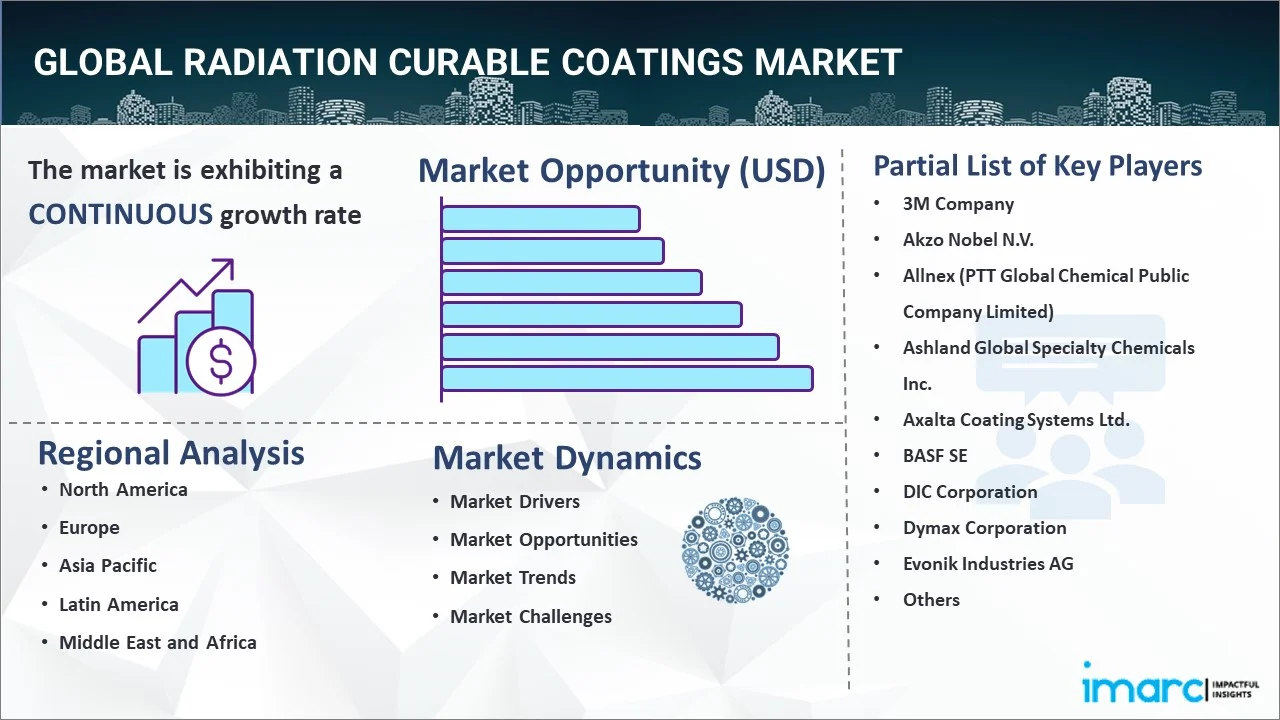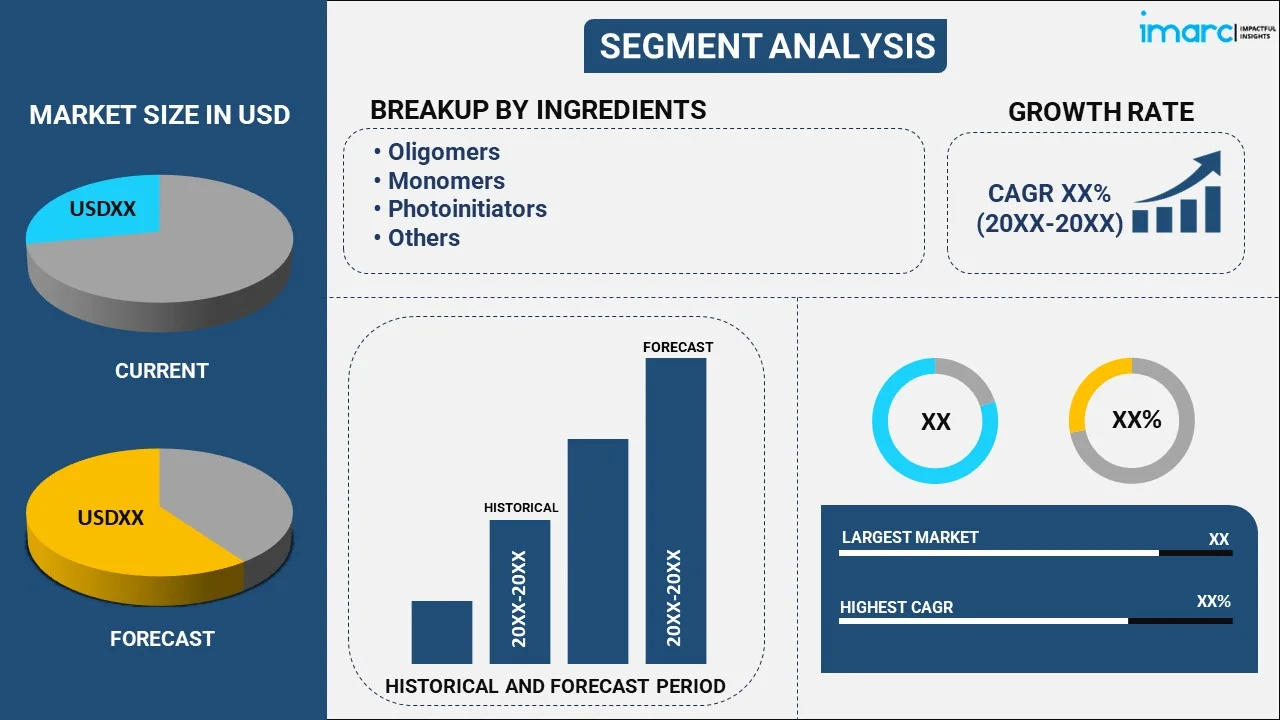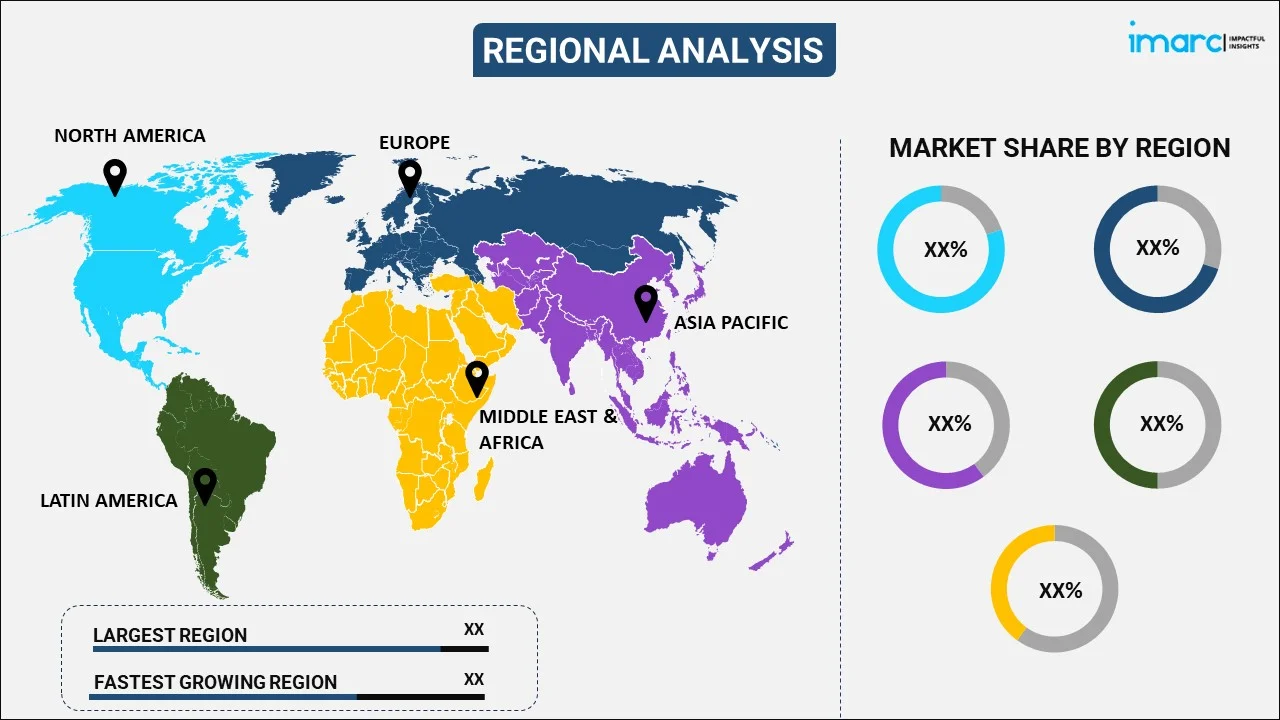
Radiation Curable Coatings Market Report by Ingredient (Oligomers, Monomers, Photoinitiators, Additives), Type (Ultraviolet Curing, Electron Beam Curing), Application (Paper and Film, Printing Inks, Plastics, Wood, Glass, and Others), and Region 2025-2033
Market Overview:
The global radiation curable coatings market size reached USD 8.4 Billion in 2024. Looking forward, IMARC Group expects the market to reach USD 12.3 Billion by 2033, exhibiting a growth rate (CAGR) of 4.06% during 2025-2033. The increasing demand for environmentally friendly and low-VOC coatings in various industries, technological advancements in curing methods, such as UV and electron beam curing, enhanced efficiency and performance, the growing focus on sustainability, and rising regulatory compliance are some of the major factors propelling the market growth.
|
Report Attribute
|
Key Statistics
|
|---|---|
|
Base Year
|
2024
|
|
Forecast Years
|
2025-2033
|
|
Historical Years
|
2019-2024
|
|
Market Size in 2024
|
USD 8.4 Billion |
|
Market Forecast in 2033
|
USD 12.3 Billion |
| Market Growth Rate 2025-2033 | 4.06% |
Radiation curable coatings comprise reactive liquid, pigments, and additives that are cured using high-intensity radiation energy from visible light, ultraviolet (UV) energy, or low energy electrons (EB). These coatings have a long service life and high performance, require low energy costs, improve surface properties, and protect against corrosion. They also offer low levels of volatile organic compounds (VOCs) and enhance resistance against scratch, impact, abrasion, chemical, and mechanical. Consequently, they find applications in various end use industries to improve the durability, function, and aesthetic appeal of components and products made using glass, plastic, metal, and wood.

Radiation Curable Coatings Market Trends:
Growing Demand for Eco-Friendly Coatings
The increasing global focus on sustainability and environmental protection has led to a significant shift toward eco-friendly coatings. Radiation curable coatings, such as UV and electron beam-cured formulations, offer low volatile organic compounds (VOCs) and minimal environmental impact. These coatings align with stringent environmental regulations and consumer preferences for greener products. Industries such as automotive, electronics, and packaging are actively seeking alternatives that reduce harmful emissions and improve workplace safety. The push for sustainable manufacturing processes has prompted manufacturers to invest in radiation curable technologies, which not only enhance environmental compliance but also improve overall product quality. This trend is expected to drive market growth as businesses prioritize sustainable practices.
Significant Technological Advancements in Curing Methods
Technological advancements in curing technologies, particularly in UV and electron beam curing, are contributing to the market growth. Innovations are leading to improved efficiency, faster curing times, and enhanced performance characteristics, which are expected to increase the overall radiation curable coatings market share. These technologies enable coatings to achieve high durability, scratch resistance, and superior adhesion to various substrates. As manufacturers invest in research and development (R&D), new formulations are emerging that offer greater flexibility, reduced energy consumption, and the ability to cure at room temperature. This continuous evolution of curing technologies not only broadens the application range for radiation curable coatings but also meets the specific requirements of diverse industries, thereby driving the market growth. Consequently, the enhanced capabilities of these coatings are attracting more businesses to adopt radiation curing solutions.
Expanding Application Areas
The expanding application areas of radiation curable coatings significantly contribute to the market's growth. These coatings are increasingly used across various industries, including automotive, electronics, furniture, and packaging. In the automotive sector, they provide durable finishes that withstand harsh conditions while enhancing aesthetics. In electronics, they are essential for protecting sensitive components from environmental damage. Additionally, the packaging industry benefits from radiation curable coatings that ensure product safety and longevity while meeting regulatory standards. As industries explore innovative applications for these coatings, the demand continues to rise. Furthermore, the ability to customize formulations for specific applications enhances the versatility of radiation curable coatings, making them an attractive choice for manufacturers across multiple sectors.
Key Market Segmentation:
IMARC Group provides an analysis of the key trends in each sub-segment of the global radiation curable coatings market report, along with forecasts at the global, regional and country level from 2025-2033. Our report has categorized the market based on ingredient, type and application.
Breakup by Ingredient:

- Oligomers
- Monomers
- Photoinitiators
- Additives
Breakup by Type:
- Ultraviolet Curing
- Electron Beam Curing
Breakup by Application:
- Paper and Film
- Printing Inks
- Plastics
- Wood
- Glass
- Others
Breakup by Region:

- North America
- United States
- Canada
- Asia-Pacific
- China
- Japan
- India
- South Korea
- Australia
- Indonesia
- Others
- Europe
- Germany
- France
- United Kingdom
- Italy
- Spain
- Russia
- Others
- Latin America
- Brazil
- Mexico
- Others
- Middle East and Africa
Competitive Landscape:
The radiation curable coatings market research report has also provided a comprehensive analysis of the competitive landscape in the global radiation curable coatings market. Detailed profiles of all major companies have also been provided. Some of the companies covered include:
- 3M Company
- Akzo Nobel N.V.
- Allnex (PTT Global Chemical Public Company Limited)
- Ashland Global Specialty Chemicals Inc.
- Axalta Coating Systems Ltd.
- BASF SE
- DIC Corporation
- Dymax Corporation
- Evonik Industries AG
- Momentive Performance Materials Inc.
- PPG Industries Inc.
- The Sherwin-Williams Company
Kindly note that this only represents a partial list of companies, and the complete list has been provided in the report.
Radiation Curable Coatings Market News:
- In October 2023, Evonik Coating Additives announced the expansion of its TEGO® Rad range of tailor-made silicone acrylates with a unique, radically crosslinkable additive for radiation-curing coatings and inks. These additives for radiation-curing inks and coatings can improve flow, levelling, and appearance, prevent cratering and allow formulators to create products with the desired level of slip and flow.
- In December 2023, AkzoNobel and China-based Wuxi El Pont Radiation Technology Company announced their partnership to explore electron beams as an alternative for curing coatings. The partnership will focus on developing processes that use electron beams to cure coatings on metal substrates.
- In July 2024, PPG unveiled the PPG DURANEXT portfolio, a comprehensive suite of electron-beam and ultraviolet curable coatings specifically engineered for the metal coil coating sector. By harnessing the power of energy curing, PPG introduced a groundbreaking solution that delivers exceptional speed and energy efficiency.
Report Coverage:
| Report Features | Details |
|---|---|
| Base Year of the Analysis | 2024 |
| Historical Period | 2019-2024 |
| Forecast Period | 2025-2033 |
| Units | Billion USD |
| Segment Coverage | Ingredient, Type, Application, Region |
| Region Covered | Asia Pacific, Europe, North America, Latin America, Middle East and Africa |
| Countries Covered | United States, Canada, Germany, France, United Kingdom, Italy, Spain, Russia, China, Japan, India, South Korea, Australia, Indonesia, Brazil, Mexico |
| Companies Covered | 3M Company, Akzo Nobel N.V., Allnex (PTT Global Chemical Public Company Limited), Ashland Global Specialty Chemicals Inc., Axalta Coating Systems Ltd., BASF SE, DIC Corporation, Dymax Corporation, Evonik Industries AG, Momentive Performance Materials Inc., PPG Industries Inc., The Sherwin-Williams Company |
| Customization Scope | 10% Free Customization |
| Post-Sale Analyst Support | 10-12 Weeks |
| Delivery Format | PDF and Excel through Email (We can also provide the editable version of the report in PPT/Word format on special request) |
Key Questions Answered in This Report
The global radiation curable coatings market was valued at USD 8.4 Billion in 2024.
We expect the global radiation curable coatings market to exhibit a CAGR of 4.06% during 2025-2033.
The rising demand for radiation curable coatings across various industries, such as automotive, electronics, packaging, etc., as they aid in improving the durability, function, and aesthetic appeal of components and products made using glass, plastic, metal, and wood is primarily driving the global radiation curable coatings market.
The sudden outbreak of the COVID-19 pandemic had led to the implementation of stringent lockdown regulations across several nations, resulting in the temporary halt in numerous production activities for radiation curable coatings.
On a regional level, the market has been classified into North America, Asia-Pacific, Europe, Latin America, and Middle East and Africa, where Asia-Pacific currently dominates the global market.
Some of the major players in the global radiation curable coatings market include 3M Company, Akzo Nobel N.V., Allnex (PTT Global Chemical Public Company Limited), Ashland Global Specialty Chemicals Inc., Axalta Coating Systems Ltd., BASF SE, DIC Corporation, Dymax Corporation, Evonik Industries AG, Momentive Performance Materials Inc., PPG Industries Inc., and The Sherwin-Williams Company.
Need more help?
- Speak to our experienced analysts for insights on the current market scenarios.
- Include additional segments and countries to customize the report as per your requirement.
- Gain an unparalleled competitive advantage in your domain by understanding how to utilize the report and positively impacting your operations and revenue.
- For further assistance, please connect with our analysts.
 Inquire Before Buying
Inquire Before Buying
 Speak to an Analyst
Speak to an Analyst
 Request Brochure
Request Brochure
 Request Customization
Request Customization




.webp)




.webp)












